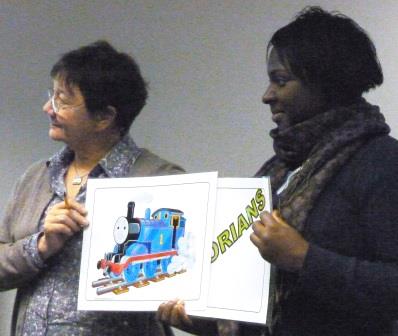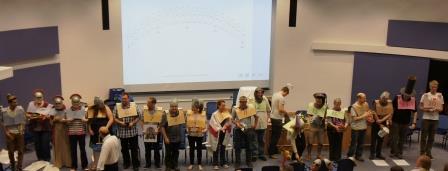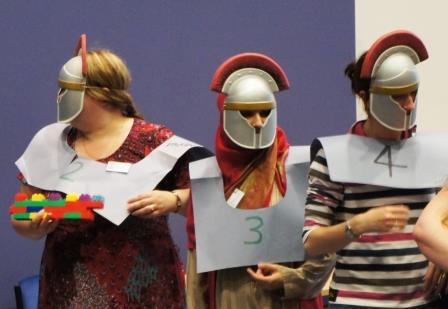The Big Human Timeline
Note: The original version of this activity [ here ] has been fully revised, specifically for Primary.
This is a very simple idea that is immensely valuable.
You use your pupils to create a human timeline one student per century from the birth of Christ to today. This human timeline then becomes the vehicle for exploring a wide range of aspects of chronological understanding there’s over a dozen variations described below but regular use with your own classes will prompt more ideas.
Timelines are a staple component of work on chronology but there’s often the danger of students being passive observers of timelines and passive observation is unlikely to lead to any lasting learning. The most productive timeline work involves children physically and mentally, whether it’s measuring out the duration of historical periods in the school playground or creating the labels ‘Tudor’ or ‘Victorian’ and researching where they go on a timeline.
This activity is part of that ‘thinking for yourself’ approach to timelines. A critical part of its success will be the sense of involvement and enjoyment you create amongst your pupils by using period hats, tabards, period labels and a range of props and pictures, all of which will make this into a strongly visual activity and make it enjoyable and memorable. ‘Memorability’ is vital - if students don’t remember an activity they can’t re-use what they’ve covered.
Three other introductory points:
1. This isn’t a one-off activity. Many aspects of ‘chronology’ need Rapid, Regular, Reinforcement so keep using this with students at regular intervals. The more children get used to it the more they’ll learn from it.
2. This is best seen as a whole school project and resource to which a range of teachers contribute in terms of collecting props and hats, making period labels and tabards and planning its use across the whole of KS2 so that you keep building up the activity across the Key Stage and so pupils gain more from the basic activity each time it’s used. Teamwork at its best!
3. Building a timeline around centuries may seem difficult when children still have to develop a strong sense of what the duration of a century is. It’s defined as a hundred years but that will not mean a great deal in reality to a 9 year-old. However the same issue still applies to teenagers and even 20-somethings who will have a stronger numerical sense of a century but still have difficulty imagining the reality of its duration. Basically in developing an understanding of the duration of a century you have to start somewhere and allow children to begin to grasp that it’s a long time, even longer than granny has lived. In fact granny can be very helpful as it’s a useful rule of thumb in KS2 that 2 grannies equals a century (though whether you can get two grannies to lie down end to end to represent a century may be unlikely!). More important than worrying about their grasp of a century is to develop understanding of the sequence and comparative duration of historical periods and allow the sense of a century to develop gradually.
And a final thought:
Don’t underestimate the power of this activity just because it’s in essence very simple.
Download
Download this guidance as a WORD file [ click here ]
Download the resources:
• A blank timeline [ click here ]
• Some period labels [ click here ]
Setting up the Basic Human Timeline
• Have students stand in a slight crescent so everyone can see everyone else. A straight line doesn’t work for visibility.
• If you don’t have enough students in your class use chairs or stuffed toys to make up the numbers or to increase the length of the line if you venture back into time BC. If you have more than 21 then start several centuries BC.
• Begin the AD centuries with a representation of Christ maybe a model from a nativity set or a doll. This can be held by the child who is the first century.
• Hand out tabards for children to wear numbered from 1-21 (and backwards into BC if you wish). The numbers represent the centuries 1st century, 2nd century etc. It’s helpful to colour code the tabards so you have a different colour for each period red for Romans, yellow for Saxon etc as this really helps create a sense of the comparative duration of the periods.
You are now ready to work on one or more of the ideas listed below. They are not listed in ‘the right order’ for introduction that will vary according to your class’s needs so pick out of the menu below what your children need.
Using the Big Human Timeline
1. What does AD mean?
Get students to say the number of their century out loud passing your visual representation of Christ down the line as they speak. Then repeat, with a slightly longer version e.g. ‘the first century Anno Domini in the year of our lord’. Or alternate centuries could say ‘AD - Anno Domini’ and ‘in the year of our lord’. You’ll soon find whichever of these works best.
2. Why is 1450 the 15th century?
Use the line to explain why the dates and centuries are seemingly out of sync you can use it as the basis for the activity:
As a follow-up put a range of dates onto flash cards (or simply say the dates aloud) ask which ‘student century’ in the human timeline has that date?
For a variation try the reverse activity go up and down the line at random asking students to identify a year in their century.
Like many of these activities don’t be afraid to do this regularly but briefly to consolidate the ideas.
3. Making sense of the BC centuries
To build up a sense of how the centuries work BC change the timeline so you have, for example, 12 centuries AD and then add 12 centuries BC. You will need your figure or other representation of Christ again to begin with to make visible that BC means Before Christ. You also need numbered tabards for the BC centuries.
Next get students to say the number of their century aloud (working back from the 1st century BC) hearing and seeing the numbers physically working in the opposite direction to the AD centuries is an important part of making sense of the concept of dates BC.
Thirdly and take care and time over this have students identify the dates of their centuries, writing them on large sheets of paper and holding them up. This again gives a clear visual sense of the reverse order BC. The pattern of BC dates always look weird if you’re not used to them so, simple though this may seem, this activity provides the familiarity and physicality that students need.
4A. Identifying periods and their sequence
This is the bedrock activity on which many of the later activities in this list are built. Ideas 4A, 4B, 4C and 4D are all closely linked.
Create a set of labels, cards or tabards (or a mix) identifying the core periods Roman Britain, Saxon England, the Middle Ages, Tudors etc.
Begin by asking students where they think each item goes on the timeline (which human century or centuries should be holding the Roman Britain cards etc?). It’s important to identify what students know or how inaccurate their ideas are, hence asking students rather than telling them.
Add period props and hats or pictures of key people or inventions to make this more fun and memorable.
There are a lot of permutations dynasties, major events, people etc to build up across KS2 so it’s important to have an overall school plan for using this core activity.

4B. Overlapping periods
For clarity’s sake it may well be best to cover the first period sequence in 4A without looking at some of the complications, notably the overlap between periods, such as the fact that the Saxons and Vikings lived in Britain at the same time. Many people assume their periods of domination follow on from each other, not overlap. Using that section of the human timeline enables children see this and other overlaps physically and this makes a great difference to understanding and memory.
Simply have the Saxon centuries (5th-11th) wear tabards of a single colour, then bring in 3 more students wearing tabards in a different colour for the Viking centuries (9th-11th). (or have these student-centuries holding two name cards if you don’t use tabards.) Place the Viking centuries alongside each Saxon century so you have two 9th centuries, 2 10th and 2 11th. This makes it very clear that the Saxon and Viking periods overlapped.
To make the 11thC even more fun add a third colour tabard for the Normans no wonder there were battles in 1066!
4C. Why do some periods have different names?
Physically labelling the timeline helps students see clearly that there are alternative names for many periods e.g. the Industrial Revolution overlaps the Georgian and Victorian periods. You can make this clear and visible by having these human centuries hold more than one label which demonstrates the point much more clearly than a verbal explanation.
Similarly you can explain overlaps and the placement of Renaissance, Reformation and Tudor all around the same period and there’s a range of other examples.
Again it’s important to plan when in KS2 each term will be first introduced and later consolidated.
4D. Going back into BC
The National Curriculum expects schools to give students an introduction to the prehistoric era, something which can appear chronologically intimidating because they are so much more unfamiliar than ‘Tudor’ or ‘Victorian’ England. It’s important not to get too hung up on knowing the dates of these periods they are, after all, approximate and different books often give slightly different dates for them. Much more helpful and accessible is to concentrate on sequence and duration the latter in particular is helped by using the human timeline. If children begin to get the hand of the sequence and duration then it’s easier to match the dates to them.
So begin by helping children understand the sequence and duration of the Stone, Bronze and Iron Ages. Again use children to represent the centuries one student per century working back from the birth of Christ. [note these are approximate dates]
Iron Age |
800 - 1BC |
8 centuries/students |
Bronze Age |
2000 - 800BC |
Another 12 centuries/students |
Stone Age |
2000BC and before |
As many students as you want to add in! |
If you can compare this with the AD side of the timeline it shows that the Iron Age was twice as long as Roman Britain, the Bronze Age 3 times as long etc and the Iron and Bronze ages together equal to the whole of history since the birth of Christ/arrival of the Romans in Britain.
The visual and physical aspect of this use of the timeline is crucial it will make far more impact and more sense for children than the raw numbers on a board.
You may also want to add in the placement and duration of any key sites or developments studied in class but you’ll need more than once class of children! However this really does get across the duration of the time involved.
For example:
Star Carr |
in use c.7000BC |
70 children in your line |
Neolithic Revolution |
6000-4000BC |
40-60 children in your line |
Skara Brae |
in use 3000-2000BC |
20-30 students in your line |
Stonehenge |
in use 3000-1500BC |
you need 15 children in your timeline to reach back to when Stonehenge was abandoned, 30 to when it was built! |
5. Duration comparing the lengths of periods
Duration is a key aspect of chronological understanding and the human timeline can help hugely to develop children’s understanding. Of course a sense of duration is hard to define, develops very slowly and is extremely hard to assess but that doesn’t mean that understanding isn’t developing when using this activity.
For example the human timeline shows very clearly the relative length of the Roman and Saxon periods compared with the Tudor and Victorian periods yes, this can be seen on a normal drawn timeline but the ideas has more impact on children taking part in the timeline. For example you can demonstrate this physically by taking the student who’s the Tudor century for a walk along all the Saxon centuries, counting them as he or she goes it’s clear the Saxon period is much longer. Similarly the length of Roman Britain stands out as longer than most realise, as does the Middle Ages.
Within centuries it’s also possible to bring in grandma’s lifetime grandma will appear very old to children but she’s not as old as a century so how many grandmas can you fit into the Roman period?
See also:
6. What does prehistoric mean?
Prehistory is defined as ‘the time before written records’. In terms of British history this means that prehistory is the immense period before the Romans brought writing to Britain. To demonstrate this give everyone in the timeline from the 1stC AD onwards a piece of paper with writing on it but extend the line back so there’s at least several people BC without paper. Explain that these centuries without writing are called the prehistoric centuries.
Now ask what’s the difference between the prehistoric centuries and those that came after? The answer lies in the writing there was no writing before 1st C so this is the time called ‘prehistoric’.
You could develop this to show that different societies began writing at different times and therefore ‘prehistoric’ means different things in different places.
7. What are The Middle Ages in the middle of?
Sit all the medieval centuries (5th-14th) down tell the 15th and 16th centuries (the Renaissance) to look snooty and know-it-all, looking down on the ignorant centuries before them. These Renaissance folk admired the Greeks and Romans and so linked themselves back to the Greeks and Romans demonstrate this by passing a rope or similar back from the Renaissance centuries (15 and 16) century to the Roman century above the heads of the medieval centuries (without it touching the medieval centuries) now you see why they’re called The Middle Ages, they’re in the middle of two lots of societies that had a high opinion of themselves!
8. Other dating systems e.g. the Islamic calendar
Thus far the human timeline has focussed on the Christian dating system but it also offers very clear opportunities to demonstrate other dating systems. For example the Islamic calendar starts in what is called 632AD in the Christian dating system so a second timeline representing the Islamic centuries in parallel with the original AD line. You could, for example, use a set of chairs to represent your original BC/AD century and use your class to represent the new Islamic centuries with the 1st century moving up to be in front of the 7th century AD.
9. Make them sort themselves out
Once students have been introduced to the timeline and, for example, major periods of history give out tabards, period labels etc to the class sitting in their seats and get them to sort themselves into the timeline. First time give them the same places in the timeline that they’d had when you guided them to get everything in the right sequence, after that mix them up let them help each other so they work as a team. This is where the most effective learning will take place because children have to think, discuss, identify mistakes, sort it out for themselves.
10. What kind of work did people do?
This can be very simple the idea is to identify how long was the period that farming dominated everyday life and how recently manufacturing and industry became the main employer. So ask the student who’s the 1st century in the timeline what was the main kind of work he or she did and guide them to the answer ‘farming’. Then get each century to say in turn ‘farming’ and pass a toy sheep or similar prop down the line as they say ‘farming’. This doesn’t change until the 19th century. This has a very powerful impact because of its simplicity it’s very hard to forget the pattern that they’ve seen and taken part in.
You could use the same simple approach for types of energy, travel and other topics.
11. Creating a research task in period groups
Instead of working with individual centuries split the line into periods Romans, Saxons, late middle ages etc. Ask each group to research the development of e.g. homes, food, leisure and having fun, travel and transport, warfare, migration etc in their period and come back to the timeline and tell their story. Having heard each story then ask the class to pick out the changes and continuities in the story over time this fits in well with the National Curriculum requirement to study ‘an aspect or theme in British history that extends pupils’ chronological knowledge beyond 1066.’


